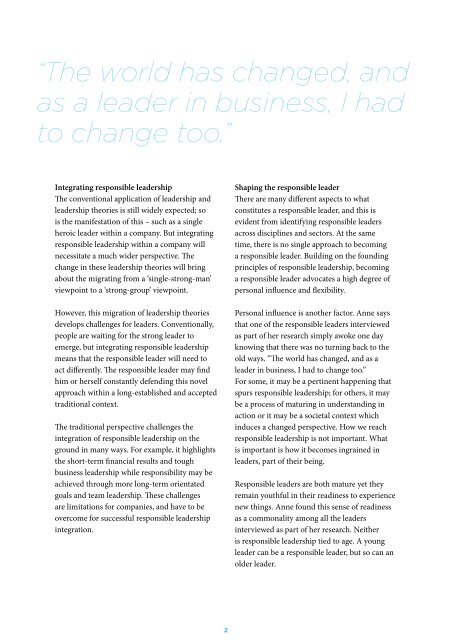Relations
GRLI_magazine_14_final_screen
GRLI_magazine_14_final_screen
Create successful ePaper yourself
Turn your PDF publications into a flip-book with our unique Google optimized e-Paper software.
“The world has changed, and<br />
as a leader in business, I had<br />
to change too.”<br />
Integrating responsible leadership<br />
The conventional application of leadership and<br />
leadership theories is still widely expected; so<br />
is the manifestation of this – such as a single<br />
heroic leader within a company. But integrating<br />
responsible leadership within a company will<br />
necessitate a much wider perspective. The<br />
change in these leadership theories will bring<br />
about the migrating from a ‘single-strong-man’<br />
viewpoint to a ‘strong-group’ viewpoint.<br />
However, this migration of leadership theories<br />
develops challenges for leaders. Conventionally,<br />
people are waiting for the strong leader to<br />
emerge, but integrating responsible leadership<br />
means that the responsible leader will need to<br />
act differently. The responsible leader may find<br />
him or herself constantly defending this novel<br />
approach within a long-established and accepted<br />
traditional context.<br />
The traditional perspective challenges the<br />
integration of responsible leadership on the<br />
ground in many ways. For example, it highlights<br />
the short-term financial results and tough<br />
business leadership while responsibility may be<br />
achieved through more long-term orientated<br />
goals and team leadership. These challenges<br />
are limitations for companies, and have to be<br />
overcome for successful responsible leadership<br />
integration.<br />
Shaping the responsible leader<br />
There are many different aspects to what<br />
constitutes a responsible leader, and this is<br />
evident from identifying responsible leaders<br />
across disciplines and sectors. At the same<br />
time, there is no single approach to becoming<br />
a responsible leader. Building on the founding<br />
principles of responsible leadership, becoming<br />
a responsible leader advocates a high degree of<br />
personal influence and flexibility.<br />
Personal influence is another factor. Anne says<br />
that one of the responsible leaders interviewed<br />
as part of her research simply awoke one day<br />
knowing that there was no turning back to the<br />
old ways. “The world has changed, and as a<br />
leader in business, I had to change too.”<br />
For some, it may be a pertinent happening that<br />
spurs responsible leadership; for others, it may<br />
be a process of maturing in understanding in<br />
action or it may be a societal context which<br />
induces a changed perspective. How we reach<br />
responsible leadership is not important. What<br />
is important is how it becomes ingrained in<br />
leaders, part of their being.<br />
Responsible leaders are both mature yet they<br />
remain youthful in their readiness to experience<br />
new things. Anne found this sense of readiness<br />
as a commonality among all the leaders<br />
interviewed as part of her research. Neither<br />
is responsible leadership tied to age. A young<br />
leader can be a responsible leader, but so can an<br />
older leader.<br />
2


